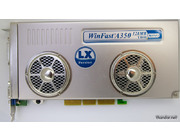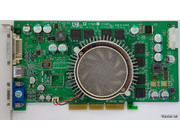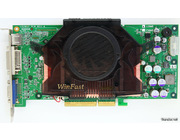Click on the blue name(s) or picture(s) below for detailed information, pictures and benchmarks (if available).
The GeForce 3 is a DirectX 8 compliant 3D-card and brought new features and techniques to the market. It has programmable shaders, LMA (Lightspeed Memory Architecture) for better memory management, reducing overdraw en compression of the Z-buffer. In terms of image quality the GeForce 3 can do bette... > Read more
I bought this card new (unused) in late 2008! Somewhere a few of these cards 'survived' in stock ![]() .
.
The GeForce 2 Pro was meant to be an high-end product and uses the GeForce 2 GTS core with faster RAM. My card, as seen on the photo's, has a GeForce 2 GTS chip with 'Pro' stamped onto it. The GTS... > Read more
The Ti4600 is, along with the Ti4400, released on 6 February 2002. A massive, fast and expensive 3D-card with good performance.
Leadtek's version of the Ti4600 comes with a large heatsink. It's working well with a low noise-level (just like GeForce2/3 cards from Leadtek). Unfortunately Leadtek st... > Read more
Leadtek's WinFast A280 is based on the nVidia GeForce 4 Ti4800-SE chip. This is an AGP8x version of the GeForce 4 Ti4400. Somehow the names of the GeForce 4 Ti aren't as expected. The first AGP4x cards were 4200, 4400 and 4600 and their AGP8x versions are 4200-8x, 4800SE and 4800. In my opinion nVid... > Read more
This card looks like a Leadtek GeForce FX 5900 XT (WinFast A350XT TDH) but it's missing the fanguard/screen on top of the cooler. However, upon closer inspection I noticed it has a) a 5900 GPU and b) the PCB-layout a (Leadtek) GeForce FX 5900.
I guess either someone replaced the GeForce FX 5900 c... > Read more
Very notable is the cooling design which seems and feels quite good. In reality it's not much high-tech as it's practically a box around the card with air flowing through. Nevertheless it looks good.
Leadtek's WinFast A350 TDH LX is based on the nVidia GeForce FX 5900 GPU. The 'LX' means it has l... > Read more
This card is based on nVidia biggest and fastest GeForce FX GPU; the 5950 Ultra.
Leadtek has done a good job on their custom cooling. It cools good and looks quite impressive. Many other companies released a GeForce FX 5950 Ultra so they had to come up with something special and attractive. Cool... > Read more
To get a better position in the market, nVidia launched the GeForce FX 5900XT GPU. This graphics processor was one of the slower parts for the high-end market. Leadtek build their WinFast A350XT using the 5900XT GPU. As the 5900XT is fitted on a high-end (but somewhat cut-down) PCB with high-end mem... > Read more
A budget card with an interesting twist: this card boasts all the ingredients for a budget card (single molex, DDR memory rather than GDDR3, lower clocks, less pipelines, D-Sub connector) but basically it's fitted with the same chip as the GeForce 6800 GT and Ultra (NV40 chips)! Of course this sound... > Read more
Not that far of from the GeForce 6800 Ultra. It's main differences are 75MHz lower core-clock, 50MHz lower RAM clock and it only uses one molex connection for extra power. Nevertheless the 6800GT was considered high-end (just about as good as the fastest nVidia card out there, just one slight step s... > Read more
A decent middle-class card. Higher clocks but narrower bandwidth compared to the 6800. Due to the higher clock frequency it's sometimes faster than it's bigger brother, but in those cases an 6800 would have enough rendering muscle to get the job done as well. After all you won't notice a difference ... > Read more
A late GeForce FX 5200 from Leadtek. It comes with the box and has sort of acceptable entry-level performance for early 2003, which is two and a half years late as this card was made in 2005 ![]() .... > Read more
.... > Read more
This entry level GeForce 6 series card has an NV44-GPU. The first GeForce 6 6200 cards use a NV43-core which is meant for the GeForce 6 6600 series. To full-fill the demand of the budget versions nVidia used defective (or perfectly working cores if they used up the 'defective-reserve') cores which c... > Read more
nVidia's first card with TurboCache technology. Cards with TurboCache have very little memory on-board and use the computers' internal RAM (through the PCI-Express bus) in case more RAM is needed. This is cheaper, but also slower.... > Read more
On Thursday 9 March, nVidia announced the GeForce 7600 and 7900 series. The 7600 GT was an ideal mid-range card with good performance, drivers and build quality.... > Read more
 Leadtek WinFast GeForce 3 TDH (AGP)
Leadtek WinFast GeForce 3 TDH (AGP)


















